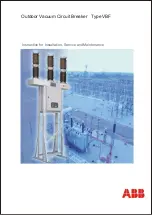
IB 6.2.11.1-1C
Page 8
ABB
K-LINE PLUS CIRCUIT BREAKER CRADLE
FEATURES
All K-Line Plus breakers use a mating cradle which
provides support and guidance to the circuit breaker so
that primary and secondary connections are made
properly. This cradle incorporates the stationary
primary and secondary disconnects, grounding
connection, interference blocking, and racking guides
and rails. Optional equipment includes: truck-operated
cell (TOC) switches, current transformers (CT’s),
mechanical interlocks, KIRK
®
Key interlocks and door
interlock.
Stationary Primary Disconnects
- The stationary
primary disconnects interface with the moving primary
disconnects mounted on the circuit breaker to provide
the LINE and LOAD connection.
Secondary Disconnect
- The cell-mounted secondary
disconnects interface with the secondary disconnects
mounted on the bottom rear of the circuit breaker to
provide the control and indicating connections to and
from the circuit breaker. The contacts are connected
when the breaker is in both the CONNECTED and
TEST positions.
Grounding Connection
- A copper connection is
provided which engages the circuit breaker in the TEST
and CONNECTED positions. Positive grounding is
provided to the cubicle frame.
Interference Blocks
- Interference blocks are mounted
on the side of the cradle to interface with those
mounted on the circuit breaker to reject the
interchanging of different circuit breaker frame sizes,
short circuit ratings, and fused versus non-fused
versions.
Truck Operated Cell (TOC) Switch
(Optional) - The
TOC auxiliary switch is operated as the circuit breaker
is racked into the cubicle. Mounted at the upper rear of
the cradle, the switch is available with four or eight
contacts. Two separate arrangements are available to
allow remote indication of the circuit breaker's drawout
position. In the standard arrangement, the cell switch
contacts change state between the CONNECTED and
TEST racking positions. A special arrangement is
available that allows operation between TEST and
DISCONNECTED racking positions.
Current Transformers (CT’s)
(Optional) - Provisions
for mounting at least one CT per phase are
incorporated into all cubicles, depending on the CT’s
rating and physical size.
Mechanical Interlock
(Optional) - Interconnected
cradle-mounted linkage permits only one of two
horizontally or vertically adjacent circuit breakers to be
closed at any time, when in the CONNECTED position.
KIRK
®
Key Interlock
(Optional) - Positions for
mounting a KIRK
®
Key interlock are available with
accessibility through the closed compartment door.
The Kirk Key is released only when the linkage on the
cradle locks the circuit breaker open when in the
CONNECTED position.
SOLID STATE TRIP SYSTEM
The MPSC-2000 electronic, microprocessor-based trip
system includes the sensors, the MPSC-2000
electronic trip device, the magnetic latch, and the
interconnecting wiring. A current sensor is integrally
mounted on each phase of the circuit breaker to supply
a value of current flowing in the trip unit which is
directly proportional to the current passing through the
primary circuit. When the value of current in the
primaries exceeds the trip unit threshold setting for a
given time in long time, short time, and/or ground, then
tripping occurs by sending a signal to the magnetic
latch. Instantaneous tripping occurs in the same
manner, but without the time delay. On three phase,
four wire, wye systems, provisions are made for input
from a separately mounted sensor to obtain a residual
connection of all four sensors for sensitivity to ground
currents.
The MPSC-2000 trip unit (Item 3
of Figure 1)
is visible
on the front of the circuit breaker. It is completely self-
powered, taking the tripping energy from the primary
current passing through the circuit breaker without the
need for any additional power supply. An external 9V
battery is supplied to permit the user to access the
MPSC-2000’s menus. The battery is not required for
correct operation of the trip device. The battery will last
only about 1-2 hours of actual use, so the switch to this
battery should be left in the “off” position except when
needed.
To cope with modern power systems where harmonics
in the system can cause cable and busway
overheating, the MPSC-2000 long time trip element
samples the current in a unique algorithm, then
calculates the root mean square (RMS) value of the
system current, providing tripping when the RMS
current is above the trip threshold. Overheating in
cable and busway is thus avoided with the MPSC-2000
trip system. Short time and instantaneous tripping
remains based on peak sensing methods, avoiding
unnecessary delay in tripping caused by the RMS
calculation.





























